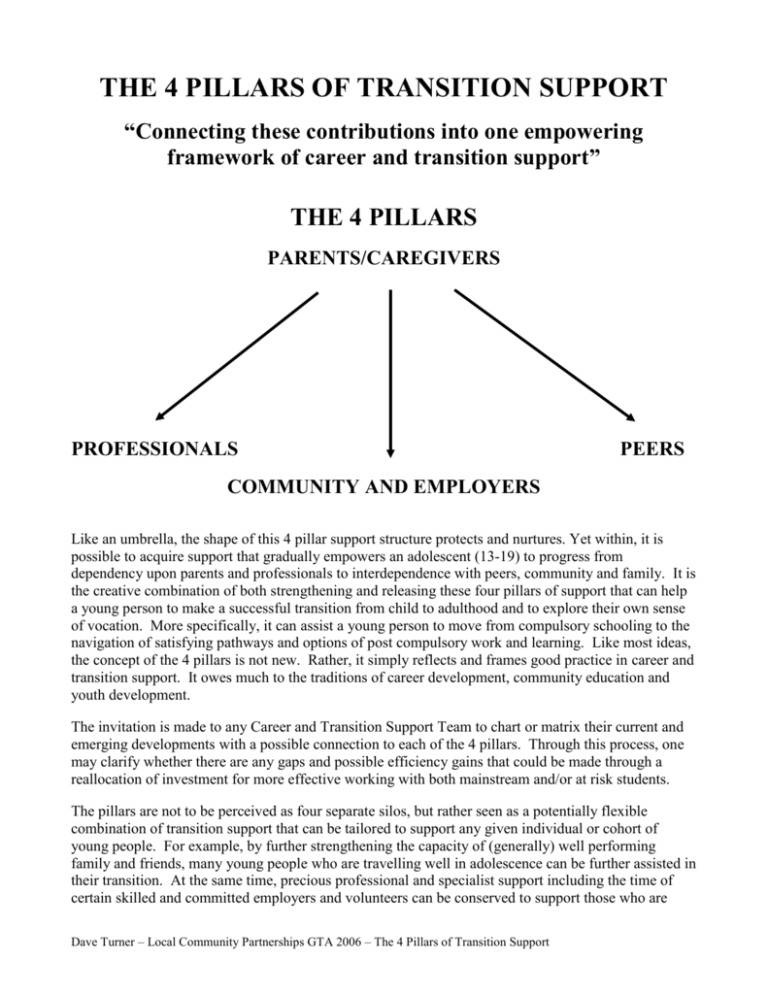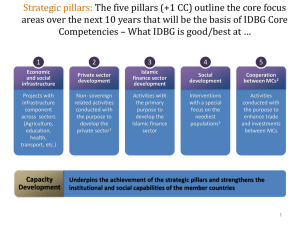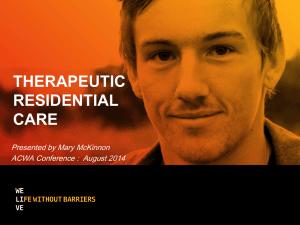THE 4 PILLARS OF TRANSITION SUPPORT
advertisement

THE 4 PILLARS OF TRANSITION SUPPORT “Connecting these contributions into one empowering framework of career and transition support” THE 4 PILLARS PARENTS/CAREGIVERS PROFESSIONALS PEERS COMMUNITY AND EMPLOYERS Like an umbrella, the shape of this 4 pillar support structure protects and nurtures. Yet within, it is possible to acquire support that gradually empowers an adolescent (13-19) to progress from dependency upon parents and professionals to interdependence with peers, community and family. It is the creative combination of both strengthening and releasing these four pillars of support that can help a young person to make a successful transition from child to adulthood and to explore their own sense of vocation. More specifically, it can assist a young person to move from compulsory schooling to the navigation of satisfying pathways and options of post compulsory work and learning. Like most ideas, the concept of the 4 pillars is not new. Rather, it simply reflects and frames good practice in career and transition support. It owes much to the traditions of career development, community education and youth development. The invitation is made to any Career and Transition Support Team to chart or matrix their current and emerging developments with a possible connection to each of the 4 pillars. Through this process, one may clarify whether there are any gaps and possible efficiency gains that could be made through a reallocation of investment for more effective working with both mainstream and/or at risk students. The pillars are not to be perceived as four separate silos, but rather seen as a potentially flexible combination of transition support that can be tailored to support any given individual or cohort of young people. For example, by further strengthening the capacity of (generally) well performing family and friends, many young people who are travelling well in adolescence can be further assisted in their transition. At the same time, precious professional and specialist support including the time of certain skilled and committed employers and volunteers can be conserved to support those who are Dave Turner – Local Community Partnerships GTA 2006 – The 4 Pillars of Transition Support considered to be more, or even most at risk. Within an “universal” system of transition support, there is still a need to dedicate differentiated levels of service to targeted groups. Any given intervention of career and transition support may focus on releasing one particular pillar or employ a combination of all four in its approach whilst taking a strategic view to invest resource most wisely. The empowering process within the 4 pillar structure is gradual and not linear. Even a mature, confident, focussed and enterprising 17 year old requires some professional support eg career counselling and parental/family backing (often financial!). Although most 13-14 year olds are clearly dependent upon their family and adult care givers, many year 10-12 students are beginning to explore and exploit the support of their peers and community whilst forging their own identity and directions. The structure and strategy of this approach helps to sustain support and encourages progression. The 4 pillars structure or framework is also open to interpretation and is therefore sensitive to cultural diversity, as it deliberately acknowledges the broader aspect of transition which encompasses the values of family and community. Career and a sense of vocation are concepts that assimilate values and aspirations of an economic, social and moral nature. Fundamentally, career and transition support is about energising the young person to release and reach their potential to contribute to society and to be rewarded. Making such a transition is multi-faceted and demands the support of parents/care givers, professionals, community and employers and young people themselves (peers). This short paper introduces the concept of the 4 Pillars of Career and Transition Support and the empowerment strategy it encompasses. A brief section on the value of each pillar and also the manifestations of that support, and how it can be tapped for young people, follows. An accompanying set of handouts offers more detail, and it is planned to produce a comprehensive resource pack that will be available by the end of 2007. 1. WORKING WITH PARENTS AND CAREGIVERS International research across OECD member nations consistently reveals that secure parent-child relationships and high parental investment are associated with progress in career development and decision making by young people. The same research consistently recommends that career educators should develop a richer view of parental involvement in the career development and transition support of young people. The research points out that parents and the informal networks of family and community including other significant adults, can be assisted to become more informed sources of guidance and support. Parents will benefit from more fully understanding the labour market and its dynamic myriad of learning pathways. Often when such networks do not exist, similar attention must be paid to supporting professionals and volunteers who are the key care givers and/or custodians. Recent research (thanks to Career Development Services Branch DET (WA)) suggests that a Career and Transition Support Team or structure could make a comprehensive and effective investment in parental involvement by implementing four interrelated and reinforcing strategies. 1. Parent as Career Partner Workshops – with an eye to creative marketing and location eg gap year and the use of community venues as well as schools. 2. Home Based Materials – interactive materials that can engage parents/care givers and children together, as well as making relevant websites more “parent friendly”. Dave Turner – Local Community Partnerships GTA 2006 – The 4 Pillars of Transition Support 2 3. Specialist Support – from a range of professionals including career counsellors and transition brokers. They are at the very hub of a successful strategy for working with parents and care givers, especially those of “at risk” young people. 4. Parental Involvement in Transition Plans – raising the profile, and making it easier for parents to contribute to the development of pathway plans and portfolios. When developing such a strategy, it is helpful to continually place parental support in context with the other three pillars. Whilst the current generation may place great emphasis upon the support of peers (and on occasions they maybe a first port of call for advice and information), they still want the “rock steady” safety net of parental support. Although not always dominant as the young person approaches adulthood, parents are an invaluable source of transition support. 2. WORKING WITH PROFESSIONALS To start with the obvious; teachers are an important resource with respect to career and transition support. Curriculum and pedagogy across the school can facilitate the career development of the student and encourage their maturation from child to adult as they graduate through the middle and senior years of schooling. Vocational learning activities and programs can be embedded into mainstream curriculum and tap all 4 pillars of support. “Just in Time” career counselling that precedes or facilitates critical career decision making is also vital. Research and case studies of good practice highlights the need for independent, unbiased and up to date advice to young people about learning and work pathways. In recent times, a range of OECD members have developed support initiatives for those young people who are considered at risk of not making a successful transition. Whether they have been called Transition Brokers, Personal Advisors or a Pathways Mentor; they have dedicated 1:1 targeted support to young people. Through a process of relationship building, needs identification (often regards multiple challenges), counselling/support, referral and signposting to other specialist services and opportunities, plus the monitoring/tracking of progress, these initiatives have offered support to targeted young people through a case management model. In some ways this kind of support reflects key aspects of the approach used by many life-coaches working 1:1 with individuals (often potential high flyers in the workplace). It is important to conserve this important, intensive and relatively high cost method of transition support to those in most need or risk. In order to do so, professionals may need to be supported within a Career and Transition Support Team to exploit the use of technology eg UK Connexions Direct service can deal with 80% of test/email contacts electronically build inter and intra-agency collaboration and partnerships that facilitate effective referral, tracking, duplication avoidance and the filling of gaps ensure those partnerships are nurtured and maintained – by not only providing a fulcrum or mediating force that balances partner agendas and contributions, but also by offering creative mechanisms of multi-faceted accountability (to funders, young people and to partners) Dave Turner – Local Community Partnerships GTA 2006 – The 4 Pillars of Transition Support 3 3. cherishing the quality and skills of specialist services and those community members (including employers) who can support the at risk. WORKING WITH COMMUNITY AND EMPLOYERS Although employers have a strong vested interest in young people making successful transitions, they are also a part of community who dedicates volunteer time to support young people. A large number of volunteers are willing and able to make a contribution to career and transition support for young people who are travelling “OK”. Yes, they may have a developmental or learning need, but for all intent and purpose, they are likely to make a successful transition with well targeted interventions – often of a short term character. Such volunteers come from employer networks who want to tackle skill shortages, boost recruitment and/or maintain their community reputation as well as seek to support young people adults who simply volunteer their discretionary time to support a young person(s). Perhaps they are a sports coach, family friend, a tertiary student seeking experience, or a parent who recognises that they are a significant adult to one of their child’s friends. A much smaller number of these volunteers have the capacity, skills and desire to support the more seriously at risk; young people who face multiple barriers to learning and transition and who are frequently challenging, at the very least vocationally confused. The work placement in the premises of such an employer/supervisor is a most precious resource. Similarly the community mentor who has the skills, and who seeks to work with this target group is special. Both are prepared to make a considerable “up front” investment in building rapport and trust and they are prepared for the longer-haul. A Career and Transition Support Team or structure can support these individuals and places of work by ensuring that they are not overloaded. This frequently means providing emotional support to the volunteer, partnering with them in the support process (ensuring respite) and offering them high quality professional development opportunities eg in mentoring or in the supervision of challenging workers. In the case of working with young people who are travelling well, the Career and Transition Support Team has a different role. These able young people may not need a high support placement or a mentor, rather they may only need a short burst/high energy learning opportunity or personal development challenge. Others who are clear about their career direction may require a structured pathway of vocational education, training and employment whilst still at school eg SBNA/VET. The Career and Transition Support Team may well offer such volunteers the effective brokerage and matching of motivated (and vocationally clear) young people to a pathway opportunity new models of vocational learning and work experience that have a low disruption factor (to the workplace) and yet offer high stimulation to the young person i.e. creative mechanisms of education-industry collaboration that are not reliant upon the placement, but other models including the facilitation and employer review of peer led projects additional opportunities to mentoring i.e. supporting individuals who want to contribute directly to young people through such vehicles as coaching, tutoring, reviewing a project or Dave Turner – Local Community Partnerships GTA 2006 – The 4 Pillars of Transition Support 4 resource person to an activity or even supporting parents and other volunteers (but without the intensive and longer term demands of mentoring). If a Career and Transition Support Team can offer such a services to employers and community volunteers, it may help conserve the rare and valuable resource that is so vital for the well being of seriously “at risk” young people. 4. WORKING WITH PEERS “Young people generate as well as receive career and transition support” A strong strand of research and practice (albeit not mainstream in OECD member policies) recognises and/or employs the concept of peer support. Whether it is psychological research (Judith Rich Harris – The Nurture Assumption), youth work surveys (Mission Australia Youth Survey), recent writing on the current generation (Hugh Mackay – Rising Generation and Y Generation writings), this approach highlights the power of peers as a source of information, achieve and support (whether informed or not) to young people the importance of working the peer group, not just the individual the never underestimating the capacity of most young people to give, as well as to receive transition support. Models of good practice occur throughout the western world, particularly with programs aimed at emerging young adults, who are chronically closer to adult than child (15½-18 years). They seek to tap, inform and add value to peer support. Some strengthen existing bonds within a cohort, whereas others also seek to help build bridges between peer groups and the broader community eg intergenerational youthwork. The proposition is that the vast majority of young people who are 15½ or older, and who are travelling well, are able to generate transition support for each other. This is particularly the case if Career and Transition Support Teams and students can work with others to offer the appropriate interventions of facilitation and trust in the skills and energy of young people. The Career and Transition Support Teams can then exploit this pillar of support and conserve more intensive and adult-provided resource for the more at risk. This does not mean that “at risk” young people should be excluded from such an approach, but they will often require more intensive support and/or structured lead-up activity before the peer support can make a positive contribution to what society deems as a successful transition. Even within the case management model, peer support can play a key role through such a mechanism as a “buddy system”. It is worth noting that for some marginalised young people, the “gang” is deemed to be the only form of support on offer. A Career and Transition Support Team or structure can develop and release peer support by developing programs of vocational learning and career education where young people investigate pathways and teach each other i.e. a young person led approach to career and transition education Dave Turner – Local Community Partnerships GTA 2006 – The 4 Pillars of Transition Support 5 helping professionals and volunteers refine their skills in facilitation – working alongside or behind the group and responding to their emerging needs as they the group takes peer action resourcing research and development which enables young people to shape and promote career and transition support services that are provided by adults eg by hiring staff, establishing career captains and school career booths, and not to overlook the proven concept of young ambassadors for the trades eg Try a Trade continuing to support peer mentoring initiatives in schools and youth services (generally a form of peer support provided by “older” young people to younger adolescents). CONCLUDING COMMENTS The empowerment process that underpins the 4 pillar framework is the gradual and deliberate strategy of enabling the young adolescent to progress from dependency upon parents and professionals to the young adult who is interdependent with their peers and community (also with their family and the professionals who now facilitate their career and personal development). This is the key principle of youth development, as articulated in the DEST AUSYOUTH project of national significance. As young people develop their peer support, and begin to lead programs/interventions of vocational learning and career education, they generate support as well as receive. Apart from helping to develop young people’s higher order employability skills of initiative and enterprise, the empowering process helps to build a sustainable supply of career and transition support in a given community. A respect for cultural diversity challenges the framework and structure of the 4 pillars to be flexible and open to revision and refinement. In certain indigenous and non-English speaking background cultures, family and/or community expectations may wish to challenge or refine the concept of empowerment presented within this concept. At local level, a Career and Transition Support Team or structure will make the necessary amendments and/or form their interventions accordingly. Relevance to the Career Advice Australia (CAA) initiative is guaranteed. A universal service must tap the 4 pillars if it is to be able to concentrate support on those most in need, yet not forget the rest. CAA seeks to establish and contribute to a comprehensive national career development and transition support system for all young Australians. Tapping the 4 pillars is consistent with the outcomes (and performance indicators) of Local Community Partnerships and Regional Industry Career Advisors, particularly their role in engaging parents, teachers, employers and young people themselves in transition support, whilst RICAs are more specifically about supporting and bringing employers to the partnership table. For LCPs, Category 2 workplace learning can be expanded and/or enhanced by implementing the range of peer support and community/employer engagement strategies that are framed by the 4 pillars structure i.e. peer support. A follow-up and much more developed resource (2007) will outline Australian and overseas case studies of such practice; for example 30 ways of engaging employers beyond the placement and the description of young person led peer support programs (for mainstream and at risk) young people that engage employers in a time-efficient and creative sense, and are facilitated by classroom teachers – ideas that will help tap additional resources for career and transition support. Dave Turner – Local Community Partnerships GTA 2006 – The 4 Pillars of Transition Support 6 Future Resources on the 4 Pillars DEST and Group Training Australia (GTA) have negotiated a developmental project that has two key aims – to explore and enhance quality partnering for transition support (especially with schools) and to introduce the 4 pillars concept to LCPs and their members/associates. A series of workshops on the 4 pillar framework will engage LCPs and their partners in a range of communities across Australia in 2006/7. At the same time, the project will document local practice that exemplifies and manifests the concepts presented in this brief paper. A full resource with detailed case studies of practical action that can be taken by a Career and Transition Support Team/structure will be made available to all LCPs by the end of 2007. Dave Turner – Local Community Partnerships GTA 2006 – The 4 Pillars of Transition Support 7







